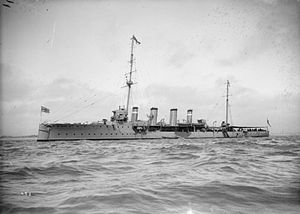HMS Boadicea (1908)

Boadicea at anchor
|
|
| History | |
|---|---|
|
|
|
| Name: | HMS Boadicea |
| Namesake: | Boadicea |
| Builder: | Pembroke Royal Dockyard |
| Laid down: | 1 June 1907 |
| Launched: | 14 May 1908 |
| Completed: | June 1909 |
| Out of service: | 18 February 1920 |
| Fate: | Sold for scrap, 13 July 1926 |
| General characteristics | |
| Class and type: | Boadicea-class scout cruiser |
| Displacement: | 3,350 long tons (3,400 t) (normal) |
| Length: | 405 ft (123.4 m) (o/a) |
| Beam: | 41 ft 6 in (12.6 m) |
| Draught: | 14 ft (4.3 m) |
| Installed power: |
|
| Propulsion: |
|
| Speed: | 25 knots (46 km/h; 29 mph) |
| Complement: | 317 |
| Armament: |
|
| Armour: |
|
HMS Boadicea was the lead ship of her class of scout cruisers built for the Royal Navy in the first decade of the 20th century. She led the 1st Destroyer Flotilla from completion until the ship was transferred to the 3rd Destroyer Flotilla in mid-1912. A year later Boadicea was reassigned to the 2nd Battle Squadron and she spent the bulk of World War I with that squadron. The ship was present at, but did not fight in, the Battle of Jutland in mid-1916. Boadicea was converted into a minelayer at the end of 1917 and made three sorties to lay her mines before the end of the war. She was placed in reserve after the war and taken out of service in 1920. The ship was used for harbour service at Dartmouth until she was sold for scrap in 1926.
Designed to provide destroyer flotillas with a command ship capable of outclassing enemy destroyers with her six four-inch (102 mm) guns, Boadicea proved too slow in service from the start of her career. Her 25-knot (46 km/h; 29 mph) speed was barely capable of matching the speeds of the River-class destroyers she led in her flotilla in 1909 and proved inadequate to match the speed of later destroyers.
Displacing 3,350 long tons (3,400 t), the ship had an overall length of 405 feet (123.4 m), a beam of 41 feet 6 inches (12.6 m) and a deep draught of 14 feet (4.3 m). She was powered by two Parsons steam turbine sets, each driving two shafts. The turbines produced a total of 18,000 indicated horsepower (13,000 kW), using steam produced by 12 Yarrow boilers that burned both fuel oil and coal, and gave a maximum speed of 25 knots (46 km/h; 29 mph). She carried a maximum of 780 long tons (790 t) of coal and 189 long tons (192 t) of fuel oil. Her crew consisted of 317 officers and enlisted men.
...
Wikipedia
